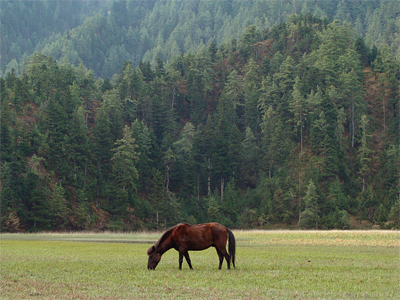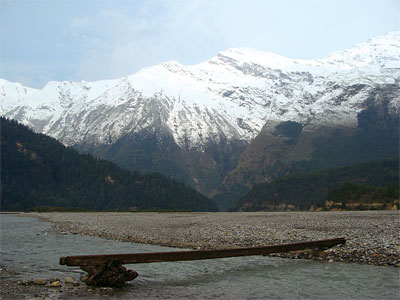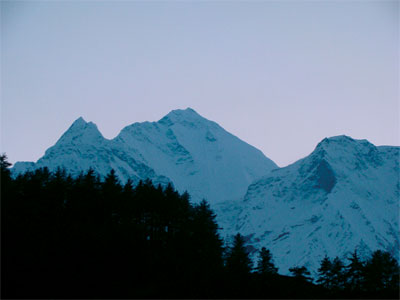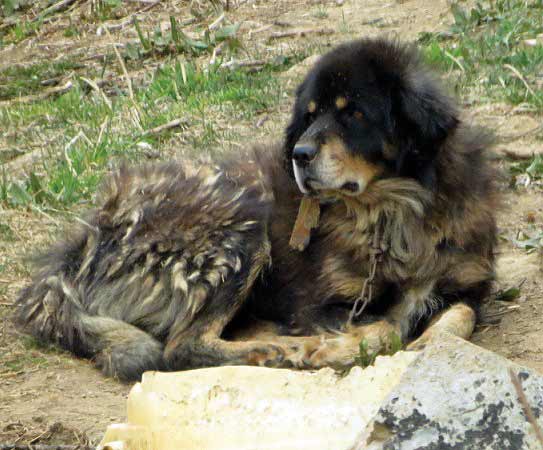It would have passed for anything but a bridge. But that is what it was. And it was the quickest way to escape the sheets of rain that had combined with the infamous winds of Mustang to drench, chill, and slow us. The bridge in question was nothing more than wooden planks nailed end to end for nearly 200 meters. It was bizarre enough even to cast doubts in the mind of my companion, a true veteran of treks in Mustang.
He stopped and looked intently at the bridge, then at the village across the Kali Gandaki River. The warmth of the hotels in that village beckoned. Somewhere from an aquifer of deep wisdom he drew the agreeable idea, and together with our porter we entered the shack on the edge of the river and ordered a bottle of rum.
Warmed and made more determined by the contents of the bottle, we stepped on to the daunting bridge. The bridge was a chain of three wooden beams, each 24 feet long and with the width of a Lonely Planet guidebook, laid out side by side and nailed to a T-shaped concrete pylon. There were 20 such sections. Because they were not firmly secured to each other, occasionally one of three would twist, causing a mild panic. So the three of us moved in a file, walking 24 feet apart so that at no point were two people treading the same plank, so that a see-saw effect wouldn’t send one of the two into the cold Kali Gandaki.
 As we climbed down a bamboo ladder and turned left to walk to the old Thakali village of Larjung, our eyes fell on the huge white slope of the mountain shaped like an open page of a book. This was May but fresh snow covered all the mountains around Larjung, reaching down to a few hundred feet above the village. The sign on that gigantic page, or so it seemed to me, was clear: climate change. Down in the valley, we had already been surprised a couple of hours ago by the rarest of occurrences in the Annapurna region—rain.
As we climbed down a bamboo ladder and turned left to walk to the old Thakali village of Larjung, our eyes fell on the huge white slope of the mountain shaped like an open page of a book. This was May but fresh snow covered all the mountains around Larjung, reaching down to a few hundred feet above the village. The sign on that gigantic page, or so it seemed to me, was clear: climate change. Down in the valley, we had already been surprised a couple of hours ago by the rarest of occurrences in the Annapurna region—rain.
In this dank weather Larjung looked like, to borrow the description of a trekker, ‘some ancient fishing village at low tide’.
It kept raining down in the valley (and snowing up in the mountains) as we sat down in the spotlessly clean living room of the Larjung Lodge, the southernmost building in Larjung. The rum had dissipated during those wobbly 200 meters of the bridge. Now, a stove full of glowing coal under the table warmed us. A young girl came in with a pan of coal, lifted the thick woolen blanket draped over the table to trap the heat, and emptied it into the stove. Moments after she let down the blanket again, we yanked our legs out from under the table. Although a solicitous gesture, the addition of coal had turned the underside of the table unbearably hot—a cause and effect that could serve as a metaphor for global warming: It is not the last coal burned that ruins the earth.
 As we watched the mud roof outside the window begin to turn slimy, it was hard not to think of change in this region that had long been associated with changelessness. Less than a week ago, we had flown into Mustang. We could have also come by road. I had seen cafés and bakeries, ATM machines and SUVs. I had long thought that the Himalayas were too high a barrier for the features of the modern world – consumerism, technology, roads – to reach the world on the other side. If they did, I believed it would take much longer than it had. In other words, I wanted Mustang to be the land of no roads and vehicles at least until I was ready for it. I had read accounts of the changes in Mustang, but I clung more to tales that spoke of it as the mystical land. Even rain, everywhere else a welcome relief, seemed as much a disruption in weather pattern as in the narrative of the region.
As we watched the mud roof outside the window begin to turn slimy, it was hard not to think of change in this region that had long been associated with changelessness. Less than a week ago, we had flown into Mustang. We could have also come by road. I had seen cafés and bakeries, ATM machines and SUVs. I had long thought that the Himalayas were too high a barrier for the features of the modern world – consumerism, technology, roads – to reach the world on the other side. If they did, I believed it would take much longer than it had. In other words, I wanted Mustang to be the land of no roads and vehicles at least until I was ready for it. I had read accounts of the changes in Mustang, but I clung more to tales that spoke of it as the mystical land. Even rain, everywhere else a welcome relief, seemed as much a disruption in weather pattern as in the narrative of the region.
We had been in the living room of the lodge for an hour when a door opened to our left and a man with the built and features of a Sherpa appeared. He turned out to be a Korean-American, a painter. He had been in Larjung for three weeks and planned to stay one more. “Terrible weather!” he remarked. “It is so strange to have this kind of weather.” We shared his feeling. But this assessment of the absurdity of the weather was based on his three-week stay, our week-long trekking. Placed on a longer time frame, Mustang always had been the center of change. It had been part of Tibet at one time, then of an independent kingdom, which was later conquered by neighboring Jumla, before they were made to relinquish control by the armies of Gorkha, following which Mustang quietly merged into Nepal. The salt trade that had once flourished in the region had been supplanted, courtesy of Tibet’s takeover by China and the arrival of a new road, by apple trade. The land that had limited visitors to a handful due to its legendary isolation had now opened up to the world, drawing thousands of them each year—a welcome change.
To be thinking about change while in Larjung, I later learned, was appropriate, for it was a point where many things had began and ended. Larjung is taken by many people to be the last village that represents Tibetan lifestyle and architecture. Some historians have conjectured that the territory of the ancient Guge Kingdom reached down to Larjung at one point. And it was in Larjung that Michel Peissel, author of Mustang: A Lost Tibetan Kingdom, abandoned his 1972 quest to journey up the Kali Gandaki on a hovercraft.
 It was almost seven in the evening when the rain stopped. I walked out on to the wet mud roof. It was wet but not sticky; the rain hadn’t lasted long enough. I climbed on the classical Mustangi ladder, which is a tree trunk with notches cut into it for steps. Immediately above the town was Dhaulagiri, a luminous wall of ice in the twilight. The Dhaulagiri Icefall appeared to be inching its way into town.
It was almost seven in the evening when the rain stopped. I walked out on to the wet mud roof. It was wet but not sticky; the rain hadn’t lasted long enough. I climbed on the classical Mustangi ladder, which is a tree trunk with notches cut into it for steps. Immediately above the town was Dhaulagiri, a luminous wall of ice in the twilight. The Dhaulagiri Icefall appeared to be inching its way into town.
The road, of course, had pipped the glacier to the town. And just as the mountains were sources of awe, the road evoked lamentations. It had torn right through the middle of Larjung, of culture, passing mere meters away from centuries old monasteries. The feeling I had on seeing roads in Mustang was the same one would have if a line were scrawled across their favorite landscape painting. The loss had been apparent in Kobang, the village we had passed through on our way to Larjung. As we walked on Kobang’s main street, my companion remembered walking the same stretch before the road came. Back then, the main street was a kind of tunnel that passed under ancient wooden houses. Nothing remained of that tunnel now, although piles of wood lined the edges of roofs, an ancient custom in Mustang. At least the old lifestyle hadn’t died out completely.
Roads maybe an anathema to the trekker, but to the locals it is a welcome change from walking for days to get a pill for their child who burns with fever. And I realize, in hindsight, it should have been easier to accept change in Larjung, anywhere in Mustang in fact. It was a place where change was the status quo: an intercontinental plate ramming into another; kingdoms beginning and ending; religions and cultures sidling; and trails and roads merging.
Something has always got to give way in this region. “This is a big, beautiful country,” my companion said eyeing the towering mountains. “But it is also a violent country. There is constant change here. We don’t see it right now, but that doesn’t mean it’s not happening.”
It was my own romantic image of a wind-blown world behind the mountains that distorted the message on the book-shaped mountain, written in fresh snow in May. It could have been about climate change, it could not. But it surely wasn’t only about climate change. It was about change in general. The mountain stood, after all, where once there had been a sea.









